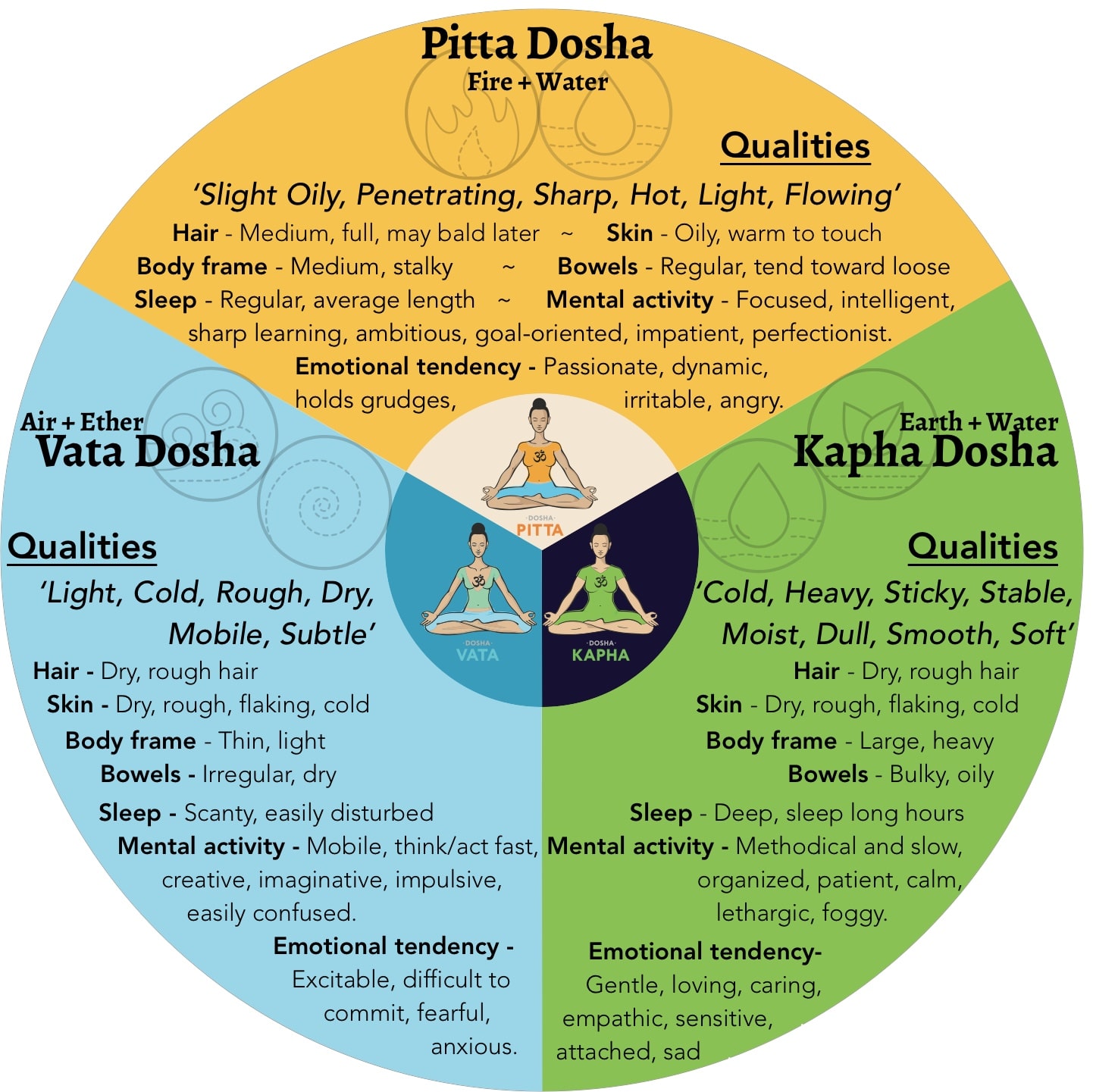Click on audio file blow to access the podcast of this article:
The elements that make up the universe are the same that combine to form the 3 Ayurvedic doshas that govern the structure and function of the body…
- Air and Space combines to make Vata
- Fire and Water combine to make Pitta
- Water and Earth combine to make Kapha
To understand the physiological activities and implications of the Dosha is difficult without understanding the elements which cause that dosha. So, let us discuss them individually in brief.
Vata Dosha:
Air is the active, space is the passive aspect of Vata dosha. Therefore, most observable aspects of Vata relates to characteristics of Air element. Vata, like air, causes movement in the body, including all nerve activity, opening and closing of protein gates on cells, movement of bowels, blood, thoughts, and attention. Considering this, Vata is described as in-charge of the nervous system, circulatory system, digestive system, and more. In terms of mental function, vata imparts the power of imagination – that is the ability to be creative, think beyond boundaries, abstract thought, vision, etc. Among emotions, Vata is predominant in states of Fear.
Because it is the only dosha with the quality of movement, Vata also causes movement of the Pitta and Kapha doshas. In other words, it plays a big role in regulating the metabolic system, lymphatic system, musculoskeletal system, hormonal system, and more.
Disorders of Vata: Because of this central function, the number of disorders associated with Vata are greatest in number. Disorders that are Vata predominant will involve primary locations of vata (like Nervous system, digestive system, etc.). Secondary Vata involvement can be observed in any system of the body.
Pitta Dosha:
Fire is the active, water is the passive aspect Pitta dosha. Therefore, more observable qualities of Pitta are related to characteristics of Fire element. Pitta, like fire, is hot, sharp, penetrating, illuminating, and all consuming. For example, Pitta dosha supports all metabolic activity of the body, including: gross digestion involving stomach acid, digestive enzymes, etc., Liver metabolism of nutrition and processing of toxins, Cellular metabolism of nutrition, cellular repair, and cellular detoxification. Inflammatory and repair activity of immune cells, and much more are also governed by pitta. In terms of mental function, pitta imparts intelligence – that is the ability to carry out thinking, processing information, decision making, execution, etc. Among emotions, Pitta is predominant in states of Anger.
Disorders of Pitta: Pitta predominant disorders primarily show aggravation of fire element at one or more primary locations of pitta (like liver, sites of inflammation, etc.). Pitta deficiency can also appear like an aggravation of Kapha dosha or excess dampness in the system. This might present as congestive blockages of upper respiratory system, certain forms of indigestion, Ama (undigested-toxic) build-up in the digestive tract, liver, or cellular levels.
Kapha Dosha:
Water and Earth elements combine in various proportion to form physical manifestation of kapha dosha. For example, plasma is primarily watery in nature, but has a soluble earthy component in the form of the protein albumin. Bone is mostly earthy and has distinct lack of water that cause its hardness. Muscles, joint capsules, vertebral discs have relatively even proportions of Water and Earth elements. The proportionality is the key to the integrity, structure and function of each of these Kapha tissues. For example, too little water in the bones make them too dry and brittle. Too much mineral (earth) in the discs and joints makes them arthritic.
Disorders of Kapha: Kapha is generally most resilient dosha against disorders. For this reason, Kapha predominant conditions are least in number. Disorders often arise when Kapha is being acted on by another dosha. Too much pitta (inflammation) can cause degeneration of structures like cells, joints, muscles, etc., depreciation of Kapha. Too little pitta can cause accumulation of Water and Earth and blockages in liver, channels of elimination etc. Too much Vata can cause channel dryness and contraction, that causes blockage, congestion, brittleness, and degeneration depending on tissues involved. Thus, when kapha dosha is involved, awareness of mechanism of disorder is as important as location of the disorder.
Learn more about Ayurvedic Medicine with Dr. Anup




